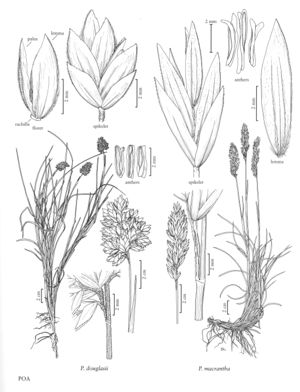Difference between revisions of "Poa macrantha"
imported>Volume Importer |
imported>Volume Importer |
||
| Line 47: | Line 47: | ||
|publication year= | |publication year= | ||
|special status=Endemic | |special status=Endemic | ||
| − | |source xml=https:// | + | |source xml=https://bitbucket.org/aafc-mbb/fna-data-curation/src/2e0870ddd59836b60bcf96646a41e87ea5a5943a/coarse_grained_fna_xml/V24/V24_771.xml |
|subfamily=Poaceae subfam. Pooideae | |subfamily=Poaceae subfam. Pooideae | ||
|tribe=Poaceae tribe Poeae | |tribe=Poaceae tribe Poeae | ||
Revision as of 20:53, 5 November 2020
Plants perennial; loosely tufted, rhizomatous and stoloniferous, rhizomes and stolons to 4 m, stout, robust. Basal branching mostly intravaginal, some extravaginal. Culms (7)15-60 cm tall, 1.5-2 mm thick, bases decumbent, terete or weakly compressed, smooth or moderately scabrous below the panicles; nodes terete, 0(1) exserted. Sheaths closed for about 1/2 their length, terete, glabrous or sparsely retrorsely scabrous, bases of basal sheaths glabrous, distal sheath lengths 1.7-4(6) times blade lengths; collars smooth, glabrous; ligules 1-5 mm, scabrous, truncate to acute, ciliolate; innovation blades to 30 cm, moderately to densely scabrous or hispidulous on and between the veins; cauline blades subequal in length, 2-4 mm wide, involute, thick, somewhat arcuate, firm, abaxial surfaces smooth or moderately to densely scabrous or hispidulous on and between the veins, apices narrowly prow-shaped, flag leaf blades 1-10 cm. Panicles 3-15 cm, erect, ovoid to lanceolate, contracted, often interrupted, congested, with 15-80 spikelets, rachises glabrous, smooth to moderately scabrous; nodes with 1-2 branches; branches 1-6 cm, erect, stiff, terete to weakly angled, smooth or sparsely to moderately scabrous, with 3-17 spikelets. Spikelets 9-17 mm, lengths to 3 times widths, laterally compressed, not sexually dimorphic; florets 3-6(10); rachilla internodes smooth, usually hairy, hairs 0.3-0.4+ mm, rarely glabrous. Glumes broadly lanceolate, subequal to the adjacent lemmas, distinctly keeled, keels sparsely scabrous near the apices; lower glumes 3-veined; upper glumes usually 7+ mm, 3-5-veined; calluses usually with a crown of hairs, sometimes glabrous or diffusely webbed; lemmas (6)7.5-11 mm, lanceolate, 5-7(11)-veined, distinctly keeled, keels and marginal veins, and sometimes the lateral veins, short-villous to softly puberulent, intercostal regions smooth or scabrous, glabrous or softly puberulent, margins glabrous, apices acute; palea keels scabrous, intercostal regions glabrous; anthers vestigial (0.1-0.2 mm) or (2)3-4(5) mm. 2n = 28.
Distribution
Oreg., Alaska, Calif., Wash., B.C.
Discussion
Poa macrantha is a dioecious coastal sand dune species that grows from southern Alaska to northern California. It competes better than P. douglasii (see previous) with the invasion of its habitat by Ammophila and other exotic species. It used to be treated as a subspecies of P. douglasii; a few intermediates with that species have been found around the mouth of Little River, California. Although clearly related, the two species are reasonably divergent in a number of characters. Poa macrantha is readily distinguished from P. douglasii by its glabrous rachises and usually longer glumes and lemmas.
Selected References
None.
